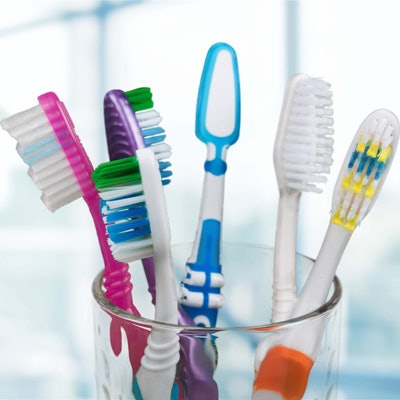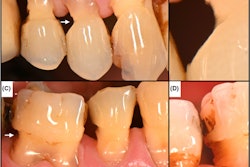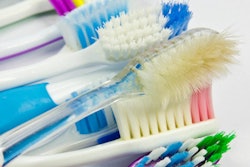
Manual toothbrushes with certain bristle types are thought to promote better plaque removal. But does a bristle arrangement place patients at risk of dentin abrasion and developing noncarious cervical lesions? Researchers simulated 10 years of brushing to find out.
Researchers created an experimental protocol in which a toothbrushing machine used five different bristle configurations and two different loads on extracted human premolars to simulate 10 years of toothbrushing. They found that bristle configuration affected the volume and shape of the noncarious cervical lesions that the brushing caused.
"Toothbrush bristle arrangement plays a role in noncarious cervical lesion development, with the ordinary/flat-trimmed version being more abrasive and the feathered toothbrush causing less wedge-shaped lesions," wrote the authors, led by Cecilia Turssi, DDS, PhD, of the division of cariology and restorative dentistry at São Leopoldo Mandic Research Institute in Campinas, Brazil (Journal of Dentistry, May 23, 2019).
A bristly situation
Previous research has found that abrasion from toothbrushing contributes to the development of noncarious cervical lesions, the loss of dental hard tissue at the cementoenamel junction.
While multilevel or angled bristle designs have been found in laboratory and clinical studies to be better at removing plaque than traditional designs, less is known about how bristle configuration, shape, and composition affects the formation and progression of noncarious cervical lesions. To learn more, the researchers of the current study examined in vitro the effects of bristle configuration and brushing load on this hazard.
They obtained 160 extracted human upper first premolars without any caries restorations, stains, or enamel or root defects. After cleaning the teeth with a periodontal scaler, the investigators mounted paired teeth on acrylic blocks to form 10 replicates.
A custom toothbrushing machine cleaned the specimens with one of five toothbrushes with various bristle configurations using a toothpaste slurry made from a midabrasive, fluoridated toothpaste (Crest Cavity Protection, Procter & Gamble) and distilled water, with a load of 1 newton (N) or 3 N.
| Characteristics of toothbrushes used in study | |||
| Toothbrush | Bristle configuration | Bristle diameter | No. of tufts |
| Oral-B Indicator Soft, Oral-B | Ordinary/flat-rimmed | 0.35 mm | 30 |
| Oral-B Contour Soft Clean, Oral-B | Rippled | 0.12 mm | 38 |
| Oral-B Pro-Health All-In-One Soft, Oral-B | Cross-angled, multilevel, rubbers added | 0.14mm/ 1.36 mm (rubber) |
30 plus 8 rubbers |
| Oral-B Clinical Pro-Flex Soft, Oral-B | Cross-angled, multilevel, flex head | 0.14 mm | 32 |
| Oral-B Compact Clean Soft, Oral-B | Feathered | Unable to measure | 33 |
The machine brushed each specimen for 55,000 double strokes, the equivalent of approximately 10 years. The investigators made impressions of the specimens at baseline and after brushing, and they scanned an area of the impression and calculated dentin loss.
After the brushing, the researchers sectioned each tooth from buccal to lingual through the center of the noncarious cervical lesion and photographed half of the tooth, after which an examiner, who was blinded to the brush configurations that had been used for the teeth, characterized its shape.
Toothbrush configuration significantly affected dentin volume loss (p = 0.003) and lesion angle (p < 0.001), although the use of different loads didn't significantly contribute to these factors, the researchers found.
Use of the ordinary/flat-rimmed toothbrush caused a greater volume of dentin loss compared with the other toothbrushes, which had similar dentin loss to each other (see table below). This may be due to the larger diameter of the nylon bristles of the ordinary toothbrush compared with the other toothbrushes, and this larger diameter may have carried a greater amount of toothpaste, the study authors explained. The rubber bristles of one toothbrush may not have affected abrasion since they are on the periphery of the toothbrush head in a lower position, they added.
| Mean volume of dentin loss with 1- and 3-N brushing loads | |||||
| Load | Ordinary | Rippled | Cross-angled/ multilevel/rubber |
Cross-angled/ multilevel/flex head |
Feathered |
| 1 N | 3.45 µm | 2.99 µm | 3.06 µm | 2.32 µm | 2.72 µm |
| 3 N | 4.18 µm | 2.84 µm | 2.60 µm | 2.81 µm | 2.97 µm |
The rubber-bristled toothbrush had noncarious cervical lesions with the smallest angle (102.97°), while the feathered toothbrush had the largest angle (130.36°). The feathered toothbrush had the smallest proportion of wedge-shaped lesions (3.1%), and the rippled (53.1%) and rubber-bristled (43.8%) toothbrushes the highest.
Cup-shaped lesions were most commonly seen with the ordinary (62.5%), feathered (71.9%), and flex head (59.4%) toothbrushes, and flat lesions were the least common overall (13.3%). Of the lesions seen in the study, 56% were cup-shaped and 31.3% were wedge-shaped.
Scarce knowledge
The study authors did not declare any limitations to the study, but they noted that while their study contributed to the scarce knowledge of the effects of toothbrush bristle configuration, additional research is needed on the abrasion caused by toothbrushing.
"Based on the current findings, one can speculate that the use of the feathered toothbrush may represent an advantageous choice over the others, assuming an additive effect of occlusal load," they concluded.
Study disclosure
The study authors reported that this project was supported by the Erosive Tooth Wear Research Program of the Indiana University School of Dentistry in Indianapolis.



















